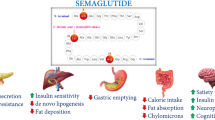Abstract
Objective
To investigate the therapeutic effects of Ping-tang Recipe (平糖方, PTR) on high-fat diet (HFD)-induced insulin resistance and non-alcoholic fatty liver disease (NAFLD), and to elucidate the underlying mechanisms.
Methods
Forty male SD rats were included in the study. Ten rats were fed on normal diet as normal control, and thirty rats were fed on HFD for 8 weeks to induce obesity, followed with low dose (0.42 g/kg) or high dose (0.84 g/kg) of PTR or vehicle for 8 weeks with 10 animals for each group. Glucose metabolism and insulin sensitivity were evaluated by oral glucose tolerance test and insulin tolerance test. Hepatic steatosis was measured by immunohistochemistry. Liver lipid metabolic genes were analyzed by quantitative real-time polymerase chain reaction, while AMP-activated protein kinase (AMPK) expression was examined by Western blot.
Results
Rats fed on HFD developed abdominal obesity, insulin resistance and NAFLD. PTR treatment reduced visceral fat (peri-epididymal and peri-renal) accumulation, improved glucose metabolism, and attenuated hepatic steatosis. The expressions of the key lipolytic regulating genes, including peroxisome proliferators-activated receptor γ co-activator 1α (PGC-1α), peroxisome proliferator-activated receptor γ (PRAR-γ) and α (PRAR-α), were up-regulated (P<0.05 or P<0.01), while the expressions of lipogenic genes such as sterol regulatory element-binding protein 1c (SREBP-1c), fatty acid synthase (FAS) and liver fatty acid-binding protein (L-FABP) were down-regulated (P<0.05 or P<0.01). In addition, PTR activated AMPK and promoted acetyl-CoA carboxylase phosphorylation in the liver.
Conclusions
PTR improves insulin resistance and reverse hepatic steatosis in the rat model of HFD-induced obesity through promotion of lipolysis and reduction of lipogenesis, which involves the AMPK signaling pathway, thus representing a new therapeutic intervention for obesity related insulin resistance and NAFLD.
Similar content being viewed by others
References
Chitturi S, Wong VW, Farrell G. Nonalcoholic fatty liver in Asia: firmly entrenched and rapidly gaining ground. J Gastroenterol Hepatol 2011;26(Suppl):163–172.
Alper AT, Hasdemir H, Sahin S, Ontürk E, Akyol A, Nurkalem Z, et al. The relationship between nonalcoholic fatty liver disease and the severity of coronary artery disease in patients with metabolic syndrome. Turk Kardiyol Dern Ars 2008;36:376–381.
Sanyal AJ. AGA technical review on nonalcoholic fatty liver disease. Gastroenterology 2002;123:1705–1725.
Ratziu V, Caldwell S, Neuschwander-Tetri BA. Therapeutic trials in nonalcoholic steatohepatitis: insulin sensitizers and related methodological issues. Hepatology 2010;52:2206–2215.
Tsochatzis EA, Papatheodoridis GV. Is there any progress in the treatment of non-alcoholic fatty liver disease? World J Gastrointest Pharmacol Ther 2011;2;1–5.
Zhang HX, Yang SY, Cao HX. Effect of Pingtang Recipe containing drug-serum on INS-1 pancreatic beta cells lipoapoptosis. Chin J Integr Tradit West Med (Chin) 2010;30;978–981.
Li XJ, Yang SY. Clinical observation on treatment of diabetes mellitus type 2 by Pingtang concentrated capsule. Chin J Integr Tradit West Med (Chin) 2002;22:854–855.
Lee MS, Kim D, Jo K, Hwang JK. Nordihydroguaiaretic acid protects against high-fat diet-induced fatty liver by activating AMP-activated protein kinase in obese mice. Biochem Biophys Res Commun 2010;401:92–97.
Ha SK, Chae C. Inducible nitric oxide distribution in the fatty liver of a mouse with high fat diet-induced obesity. Exp Anim 2010;59:595–604.
Kucera O, Garnol T, Lotková H, Staňková P, Mazurová Y, Hroch M, et al. The effect of rat strain, diet composition and feeding period on the development of a nutritional model of non-alcoholic fatty liver disease in rats. Physiol Res 2011;60;317–328.
Orlik B, Handzlik G, Olszanecka-Glinianowicz M. The role of adipokines and insulin resistance in the pathogenesis of nonalcoholic fatty liver disease. Postepy Hig Med Dosw 2010;64;212–219.
Qin Y, Tian YP. Preventive effects of chronic exogenous growth hormone levels on diet-induced hepatic steatosis in rats. Lipids Health Dis 2010;9;78.
Matsumoto M, Ogawa W, Akimoto K, Inoue H, Miyake K, Furukawa K, et al. PKClambda in liver mediates insulininduced SREBP-1c expression and determines both hepatic lipid content and overall insulin sensitivity. J Clin Invest 2003;112;935–944.
Cao H, Maeda K, Gorgun CZ, Kim HJ, Park SY, Shulman GI, et al. Regulation of metabolic responses by adipocyte/macrophage fatty acid-binding proteins in leptin-deficient mice. Diabetes 2006;55;1915–1922.
Liang H, Ward WF. PGC-1alpha, a key regulator of energy metabolism. Adv Physiol Educ 2006;30;145–151.
Gruzman A, Babai G, Sasson S. Adenosine monophosphate-activated protein kinase (AMPK) as a new target for antidiabetic drugs: a review on metabolic, pharmacological and chemical considerations. Rev Diabet Study 2009;6:13–36.
Barroso E, Rodríguez-Calvo R, Serrano-Marco L, Astudillo AM, Balsinde J, Palomer X, et al. The PPARβ/δ activator GW501516 prevents the down-regulation of AMPK caused by a high-fat diet in liver and amplifies the PGC-1α-lipin 1-PPARα pathway leading to increased fatty acid oxidation. Endocrinology 2011;152:1848–1859.
Yuan HD, Yuan HY, Chung SH, Jin GZ, Piao GC. An active part of Artemisia sacrorum Ledeb. attenuates hepatic lipid accumulation through activating AMP-activated protein kinase in human HepG2 cells. Biosci Biotechnol Biochem 2010;74;322–328.
Canto C, Auwerx J. PGC-1alpha, SIRT1 and AMPK, an energy sensing network that controls energy expenditure. Curr Opin Lipidol 2009;20;98–105.
Zhang BB, Zhou G, Li C. AMPK: an emerging drug target for diabetes and the metabolic syndrome. Cell Metab 2009;9;407–416.
Author information
Authors and Affiliations
Corresponding author
Additional information
Supported by the National Natural Science Foundation of China (No. 30973912); and the Innovation Project of Fujian Provincial Health Bureau (No. 2007-CXB-10); and the Project of Technology Bureau of Xiamen City (No. 3502Z20077050)
Rights and permissions
About this article
Cite this article
Yang, Sy., Zhao, Nj., Li, Xj. et al. Ping-tang Recipe (平糖方) improves insulin resistance and attenuates hepatic steatosis in high-fat diet-induced obese rats. Chin. J. Integr. Med. 18, 262–268 (2012). https://doi.org/10.1007/s11655-012-1023-0
Received:
Published:
Issue Date:
DOI: https://doi.org/10.1007/s11655-012-1023-0




